Top 7 Best Microcontrollers in 2024
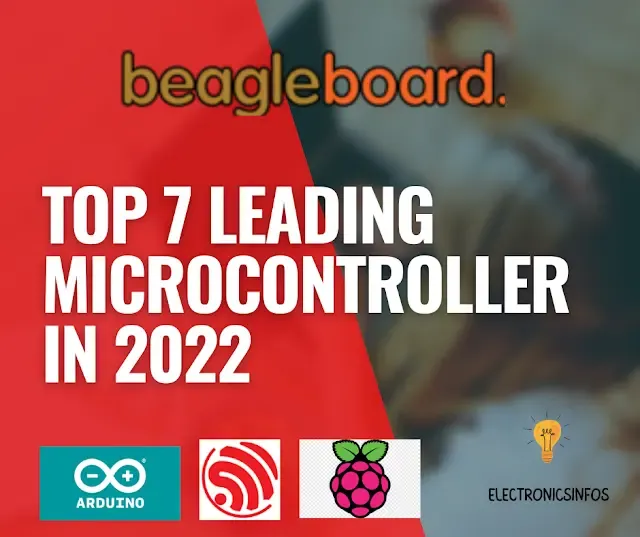 |
| 7 Best Microcontrollers 2024 |
What is a microcontroller?
A microcontroller is an integrated circuit that contains a microprocessor along with memory and programmable input/output peripherals. A microcontroller is installed within a framework to Regulate the specific capacity of a gadget.
Microcontrollers are utilized during a wide cluster of frameworks and gadgets. These gadgets are regularly used by numerous microcontrollers that cooperate inside the gadget to deal with their separate undertakings.
Components of a microcontroller
- The processor (CPU)
- Memory
- I/O peripherals
The processor (CPU)
A processor is often considered the cerebrum of the gadget. It executes different guidelines that direct the microcontroller's capacity. This includes a primary number of juggling, rationale, and input/output tasks.
Memory
A microcontroller's memory is utilized to store the information that the processor gets and uses to answer guidelines that it's been customized to do.
A microcontroller has two main memory types
- program memory (Read Only Memory)
- information memory (Random Access Memory)
Program memory is a non-volatile memory, meaning it holds data over a long time without requiring an external power source. the other name is called ROM(Read Only Memory)
Information memory is expected for brief information stockpiling while the guidelines are being executed. Information memory is volatile, meaning the information it holds is brief and is possibly kept up assuming the gadget is associated with a power source. the other name for information memory is RAM(Random Access Memory)
I/O peripherals
The I/o ports get data and send it to the processor. The processor gets that information from the I/o ports and then sends the directions to yield gadgets that execute to the microcontroller. the primary instrument that predicts a program to the microcontroller is an integrated Development Environment (IDE).
Different Types Of Microcontrollers
- Arduino Uno R3 Microcontroller Board
- Arduino Pro Mini 328
- ESP32 Microcontroller Board
- MBED LPC1768
- Raspberry Pi 4
- Teensy 4.0
- BeagleBone Black
Arduino Uno R3 Microcontroller
The Arduino UNO R3 is a microcontroller in the group of Arduino. Arduino Uno r3 is a recent board of the Arduino Family. The main benefit of this board is if we find an error we can change the microcontroller on the board as per requirements.
The programming of this board utilises an Arduino PC program. This board has gigantic help from the Arduino people group, which can make an exceptionally straightforward method for beginning working on installed gadgets and tons more applications.
 |
| Tech Specs of Arduino UNO R3 |
Power Supply
The power source is chosen consequently. Outer power can come either from an AC-to-DC connector or a battery. The connector is used by stopping a 2.1mm focus positive
The board can work on an outer inventory from 6 to 20 volts. Whenever given under 7V, in any case, the 5V pin might supply under five volts and therefore the board might become unsound. On the off chance that utilizing quite 12V, the voltage controller might overheat and harm the board.
The power pins are the following
Vin
The Arduino power source (instead of 5 volts from the USB association or other controlled power source). You can supply voltage through this pin, or on the other hand, if providing voltage utilizing, access it through this pin.
5V
This pin uses 5V from the controller on the board. if we use power through the USB power connector its range is (5V), and the VIN pin of the board whose voltage range is (7-12V).
3V3
A 3.3-volt supply is used by the installed controller. The greatest current draw in a circuit is 50 mA.
GND
The ground pin on the microcontroller is used for grounding purposes.
IO REF
This Io ref pin is a reference pin on the Arduino board that provides the voltage reference on which the microcontroller works. the suitable power source or empower voltage interpreters on the results to figure work with the 5V or 3.3V.
Memory
The ATmega328 has 32 KB of Memory. SRAM memory is 5kb and the EPROM memory is 1 kb.
I/O peripherals
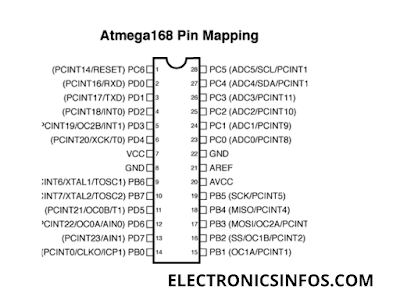 |
| I/O Peripherals of atmega 168 |
Arduino Pro Mini 328
The main benefit of Arduino Pro Mini is its low expense, adaptability and small size. In designs, we use to least parts to hold the expense down. It's the decision for a load-up you need to leave installed in a task.
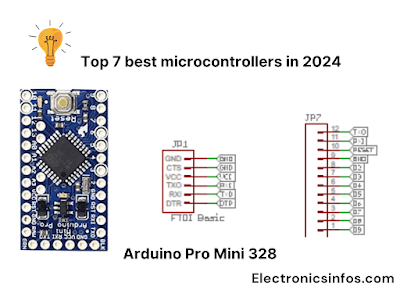 |
| Arduino Pro Mini 328 Microcontroller 2024 |
There are two power ratings of the board: The primary works at 5V (like most Arduino sheets), and therefore the other works at 3.3V. The main benefit of this board is in the event we can find an error.
we can change the microcontroller on the board as per needs. The programming of this board can be utilizing an Arduino PC program
 |
| Pin Diagram of Arduino Pro mini 328 |
Power Supply
The Arduino Pro Mini will be often powered with an FTDI cable. the Arduino Pro mini power supply with a regulated voltage is 3.3V or 5V supply on the Vcc pin. There is a voltage regulator on the board so we can regulate voltage up to 12VDC.
RAW
A raw pin is used to power up a raw voltage for the board.
VCC
The regulated voltage of this board is a 3.3 or 5-volt supply.
GND
This is a Ground pin used for grounding purposes.
Memory
The total memory of ATmega328P has 32 kB of flash memory. 0.5 kB is used for the bootloader.
I/O peripherals
14 digital I/O pins on the Pro Mini board can be used as an input or output.
- RAW
- VCC
- GND
- Digital Pins 14 digital I/O pins
- PWM (Pulse Width Modulation) pins,(6 pins)
- analogue pins numbered from A0 to A7 (6 analogue pins)
- UART pins
- external interrupt
ESP32 Microcontroller Board
ESP32 Microcontroller manufactured by Shanghai-based Espressif Systems. it costs less than $5.ESP32 is a series of low-cost, low-power systems on a chip microcontroller with integrated Wi-Fi and a dual-mode Bluetooth system.
Power Supply
The EDP32 can be powered with 3.3 V DC. The EDP32 with a regulated voltage is 3.3V or 5V supply on the Vcc pin to power up the board. There is a voltage regulator on board so it can regulate voltage values up to 12VDC.
Memory
The Memory is classified as
- ROM memory = 448 KB
- flash memory= 32 KB
- bootloader Memory = 0.5kB
- SRAM Memory = 520 KB
- eFuse memory = 1kbit
I/O peripherals
The ESP32 chip comes with 48 pins
- 18 Analog-to-Digital Converter (ADC) channels
- 3 SPI interfaces
- 3 UART interfaces
- 2 I2C interfaces
- 16 PWM output channels
- 2 Digital-to-Analog Converters (DAC)
- 2 I2S interfaces
- 10 Capacitive sensing GPIOs
MBED LPC1768 Microcontroller Board
The mbed NXP LPC1768 is a simple to-utilize MCU advancement board. its heart is a strong 32-bit ARM Cortex-M3 processor running at 96 MHz with a 512 KB streak and 32 KB RAM,
An extensive firmware library and a lot of test code assist you with making your program ready rapidly, and a free web-based IDE and C++ compiler implies that no product establishment is required. Downloading programs is all around as straightforward as utilizing a USB streak drive.
Power Supply
Vin
The input voltage of the MBED LPC 1768 voltage is +5 Volt, and the current is 100mA.
Vb
The battery backup of this input for Real-Time Clock is 1.8v-3.3v, and the current value is 30uA.
nR
Active-low reset pin with identical functionality to the reset button.
Memory
I/O peripherals
- 40-pin DIP
- USB port
- USB client /Host
- 2.4G board Antenna
- IEEE 802.15 Wireless
- Ethernet RJ45
- Micro SD
Raspberry Pi 4 Microcontroller Board
The Raspberry Pi 4 Model B is the most recent item in the Raspberry Pi range, flaunting a 64-digit quad centre processor running at 1.5GHz, double band 2.4GHz and 5GHz remote LAN for pi4, the Bluetooth modal is 5.0/BLE, this board contains genuine Gigabit Ethernet. this Raspberry Pi 4 ability through a different PoE HAT.
Power Supply
- 5V DC via USB-C connector (minimum 3A*)
- 5V DC via GPIO header (minimum 3A*)
- this board require separate Power over Ethernet (PoE)
Memory
- 4GB LPDDR4-3200 SDRAM
I/O peripherals
- The Broadcom modal is BCM2711which is Quad-core Cortex-A72 (64-bit) SoC @ 1.5GHz clock cycle
- this board contains 2.4 GHz and 5.0 GHz IEEE 802.11ac wireless modal, the Bluetooth modal is 5.0, BLE
- Gigabit Ethernet
- There are 2 USB 3.0 ports and 2 USB 2.0 ports.
- There are 2 × m2 × micro-HDMI ports support-lane MIPI DSI display port
- 2-lane MIPI CSI camera port
Teensy 4.0 Microcontroller Board
Teensy 4.0 is the fresh Teensy Microcontroller board. teensy 4.0 is the fastest and most powerful peripherals. the form factor of teensy is 1.4 by 0.7inch. It features an ARM Cortex-M7 processor at a 600MHz clock cycle, which contains an NXP iMXRT1062 chip,
Teensy 4.0 is the same size, and shape as Teensy 3.2.this retains compatibility with most of the pin functions on Teensy 3.2.
Power Supply
- 5V DC via USB-C connector (minimum 3A*)
Memory
- ARM Cortex-M7 at 600MHz
- 1024K RAM (512K is tightly coupled)
- 2048K Flash (64K reserved for recovery & EEPROM emulation)
I/O peripherals
- 2 USB ports, both 480MBit/sec
- 3 CAN-Bus (1 with CAN FD)
- 2 I2S Digital Audio
- 1 S/PDIF Digital Audio
- 1 SDIO (4-bit) native SD
- 3 SPI, all with 16 words FIFO
- 3 I2C, all with 4-byte FIFO
- 7 Serial, all with 4-byte FIFO
- 32 general-purpose DMA channels
- 31 PWM pins
- 40 digital pins, all interrupt capable14 analogue pins, 2 ADCs on chip
BeagleBone Black Microcontroller Board
BeagleBone Black is a low-cost, community-supported development platform for developers and hobbyists. Boot Linux in under 10 seconds and get started on development in less than 5 minutes with just a single USB cable.
Power Supply
- 5V DC via USB-C connector (minimum 3A*)
Memory
- 512MB DDR3 RAM
- 4GB 8-bit eMMC onboard flash storage
- 3D graphics accelerator
I/O peripherals
- Dual Arm® Cortex®-A15 microprocessor subsystem
- 2 C66x floating-point VLIW DSPs
- 2.5MB of on-chip L3 RAM
- 2x dual Arm® Cortex®-M4 co-processors
- 4x Embedded Vision Engines (EVEs)

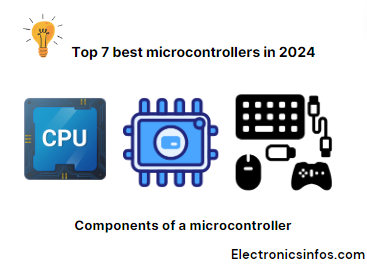
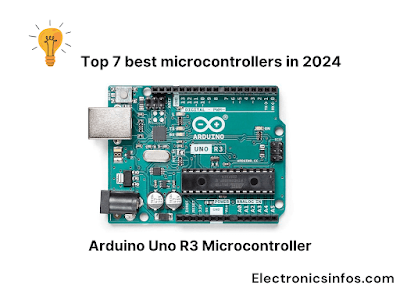

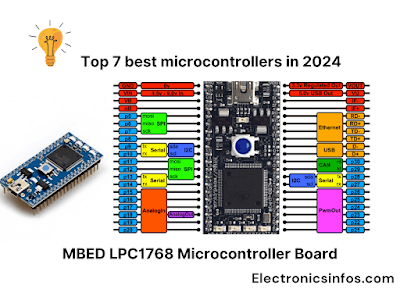

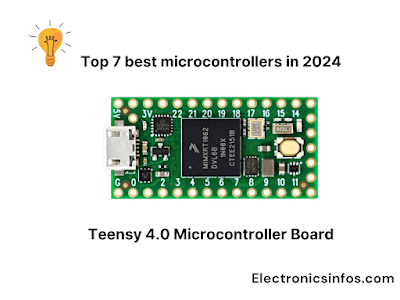

.png)

-Electronicsinfos.png)

0 Comments
please do not insert spam links